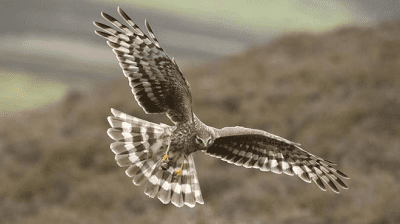Jottings – 10 September 2019 – The other side of the coin… Reg Snook
Hen harriers have always posed a problem in England, ie every breeding season it becomes RSPB versus the grouse shooters who represent big money and who can pay £150 for each brace of grouse that they shoot. Shooting begins on the glorious 12th (August). The problem is that in order for shooting to take place, there has to be grouse and gamekeepers are responsible for their provision, which requires areas of heather to be burnt off so that the young grouse can feed on new heather. Now, there is another problem in that hen harrier chicks are sometimes fed on young grouse. Therefore, on the moorlands of England there is a conflict of interests and adult hen harriers have disappeared, some are found shot and eggs and young also disappear, despite this bird’s full protection by law.
 There was as a recent report of a hen harrier nest failure due not to shooters but to RSPB/Natural England. A nest of three young harriers in the Peak District of Derby were to be fitted with rings and tracking devices, with an ITV camera crew engaged to film the ringing and fitting of the device. Later, two young harriers were found dead, and the third had disappeared. It is alleged that too much interference by licensed ringers and TV crew caused the adults to desert their young. Grouse shooters blamed the RSPB and vice versa. I have often wondered when transmitters are fitted to say cuckoos if this process can result in the death of these birds. I know that we need to gain more knowledge to assist with their protection, but I just wonder… A recent interesting radio programme gave a different picture of a grouse moor in Wensleydale. Yes, part of the moor is burnt, yes, clients pay to shoot grouse, but on the moor other birds are protected and thirty-three pairs of curlews nested there this year. Other nesting birds included redshank, lapwing, golden plover, common snipe, wheatear, ring ouzel, merlin, kestrel, buzzard, peregrine and of course hen harrier. So, there is another side to the coin. However, to protect these nesting and declining species, control of vermin takes place. Traps are set for stoat, weasels and rats, foxes are controlled as are crows and gulls. I know how I feel about this.
There was as a recent report of a hen harrier nest failure due not to shooters but to RSPB/Natural England. A nest of three young harriers in the Peak District of Derby were to be fitted with rings and tracking devices, with an ITV camera crew engaged to film the ringing and fitting of the device. Later, two young harriers were found dead, and the third had disappeared. It is alleged that too much interference by licensed ringers and TV crew caused the adults to desert their young. Grouse shooters blamed the RSPB and vice versa. I have often wondered when transmitters are fitted to say cuckoos if this process can result in the death of these birds. I know that we need to gain more knowledge to assist with their protection, but I just wonder… A recent interesting radio programme gave a different picture of a grouse moor in Wensleydale. Yes, part of the moor is burnt, yes, clients pay to shoot grouse, but on the moor other birds are protected and thirty-three pairs of curlews nested there this year. Other nesting birds included redshank, lapwing, golden plover, common snipe, wheatear, ring ouzel, merlin, kestrel, buzzard, peregrine and of course hen harrier. So, there is another side to the coin. However, to protect these nesting and declining species, control of vermin takes place. Traps are set for stoat, weasels and rats, foxes are controlled as are crows and gulls. I know how I feel about this.
I have recently recalled some amusing visits I made as a DEFRA wildlife inspector. Here is another. Essex RSPB got in touch with DEFRA saying that it had come to their notice that a dockworker at Harwich was housing birds of prey in his garden and asked if he was registered to do so. No, he was not. I was sent to Harwich to sort this out. I rang the doorbell to be greeted by loud snarls and barks. A woman’s voice yelled to the dogs to be quiet and, through frosted glass, I explained the reason for my visit. Her husband was at work at the nearby docks, and a phone call got him to come and meet me. He was a very well-built man, and he agreed to show me the birds in his care which included hobby, kestrel and American kestrel, all of whom were in a terrible condition. He had no paperwork and was not registered with DEFRA. It was then I saw out of the corner of my eye a rather small chicken shed and sitting on a perch among all the wire-netting was an eagle, but not just any old eagle. I had only seen this species of eagle once before, when I was trudging through a rainforest in the darkest of Africa wearing Army boots with a 7.62 SLR slung over my shoulder. This bird was a Cassins hawk eagle, looking thoroughly miserable and probably thinking, “what the hell am I doing here?” I excused myself, phoned the Essex RSPCA, the police and DEFRA who all descended on this man at the same time. Everything was confiscated, and the eagle went to a Zoo (the country of origin would not accept it back). I did not visit this large Essex dockworker ever again!
To View Reg’s Nature Notes Archive, please click here